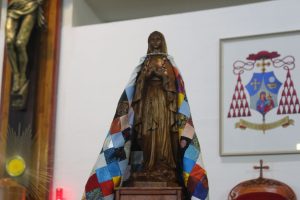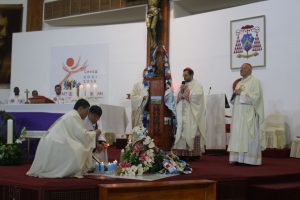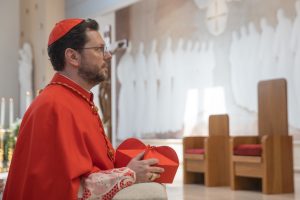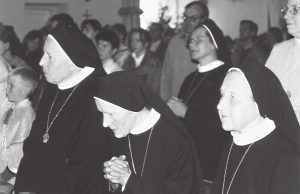–What do you think is the mission of the Catholic Church in Mongolia?
-I would say the same as anywhere in the world, which is receiving the Gospel of Jesus Christ and sharing it with the others. And it is the fundamental vocation of every catholic believer to be reached by the good news of salvation and Jesus Christ and to become an authentic witness to society.
For the Church in Mongolia this has also the particular meaning of being a Church in a minority situation in which our witness is particularly important because of the reality of the country. So, as Pope Francis said in “Evangelii Gaudium”, the identity of the Church is to be constantly evangelized and to become disciples and missionaries of the Gospel in the given Society.
-Is there anything special about the life of the Сatholics in Mongolia?
-To answer this question I would like to quote one man I’ve met a few weeks ago. I know him personally. He became a catholic only a few years ago. He is in his sixties, he is not a young man. And he told me: “You know, cardinal, by becoming a catholic my life has not changed in such a way that things become completely different, but at the same time everything has changed. Because now my daily life is full of the presence of the Lord Jesus. So that I can live my daily life with all the troubles and the joys and difficulties that every life has, with the new hope”.
And I think this is something peculiar of the small flock of catholics in Mongolia, that when they welcome the presence of the Lord Jesus Chirst in their lives they accept it with a lot of enthusiasm and they may become witnesses to the others.
And so as I said before, the particular reality of the Church in minority becomes an opportunity for these brothers and sisters of ours to bring life to the Lord and to receive Him practically and to offer the simple witness. I think this dimension of enthusiasm and joy and following the Lord is somehow special in Mongolia.
–How do people usually come to Church in Mongolia?
-Every person has a different story for sure, so we have people who were attracted by the activities of the Church. I would say, maybe most of them were attracted by the number of activities in which the Church is involved, especially social activities. But also personal journeys are very different from one another.
Like I remember one lady who followed me secretly when I was going to the market. And I felt someone was following me until I reached the Church. And this lady came out and said: “Yes, I’m following you, I want to know why as a foreigner do you live here with us and I want to know more about your life”. And so she started her journey of faith and eventually she became a very active member of the Catholic community.
So, very different motivations, but in a nutshell we could say that the witness of other Catholics is very much important for those who have no idea of our faith. So somehow this brings them to be more receptive to Evangelization.
–What are the perspectives of the Church in Mongolia?
-One thing I believe we are journeying to is a Church that is more and more rooted in the local reality. We celebrated our first 30-th anniversary last year with great joy and gratitude for all the sacrifice of the missionaries who spend their lives there, for the significant results of their evangelization considering the short amount of time. But something we felt last year when we had that pastoral week in which we evaluated our reality was that we really need to be more and more rooted to go deeper and deeper into a society. So that our faith doesn’t seem something external or foreign, but that takes more root in the society.
I think that this is the challenge of every evangelization process. As Saint Paul the VI said, evangelizing means not just painting something exteriorly but penetrating to the strict and deep dynamics of the culture to grow simply with our daily life of communion with Jesus Christ: liturgy, serving the poor, announcing the Gospel, being active in the society, reaching the deeper level in the life of the people and the foreign society.
–Can you tell a bit more about the social projects you mentioned? What are they aimed for? Who do they serve?
-The main goal of these projects is to simply live out the Gospel values. I liked what I heard a few days ago during our conference by bishop Adelio, who said technically speaking there is no pre evangelization, because either evangelization is authentic or there is no evangelization. And so whenever we do something good for others in terms of health, education, social attention, justice, it is already a manifestation of the Gospel, because the Lord Jesus, when he came among us, he took that decision of being a humble servant to manifest through His life the goodness of His Heavenly Father.
So the commitment of the Church in Mongolia is really to manifest through a number of social activities the Gospel values, the values of beatitudes, bringing also a significant contribution to the development of the society not because of any ideology or any given school of thought, but because simply the Gospel has to be seen in people who spend their energies, their lives, their resources for the good of others. And so we are very much involved, 71% of our activities are aimed at serving the society in which we live: in education, health, social development projects and also in researching into having a deeper understanding of the local culture.
We have a cultural center named after a famous expert of mongolian studies father Anton Mostar who was the CICM missionary and through researching cultural values, the language of the Mongols, their history and their traditions we also believe that we contribute to a better society.
And one proposal for these coming years would be to have the unified project that will manifest even more explicitly the corporate commitment of the whole community, not only one society, one congregation, but a local church as such to be involved in comprehensive project which will be called “House of mercy” – a place, where people, who find difficult to reach the end of the day may know that they can go there and receive assistance: a first aid assistance in terms of health, and someone who listen to them, a place, where they can go wherever they are lost in life. And we hope that that would be an eloquent sign of the Gospel in Mongolia.
–Can you give some examples of the projects you run in Mongolia?
-We have a number of preschool projects, like informal and formal kindergartens for children aged 2 to 5. When I say formal and informal, we have three big kindergartens, even one Montessori kindergarten run by some Korean sisters, which fully implement the program of the ministry of education. And other informal ones like in the countryside where I used to be, we had a big yurt, a big gir, where we were hosting 25-30 children with two mothers of the district, one of course with a license to be a teacher, but another one mostly just a volunteer. And we take care of the children to help the families to have someone caring for their education and preschool programs.
Then we have three official schools grade 1 to 12, which provide a very good educational program. Then we have a technical school run by the salesians, where young men and women are trained in particular professions like carpenters or secretaries or auto mechanics and so forth. Then we have several youth and children centers, we call them after class programs – places where children or youth can come either before or after going to school and do their homework and study in a good environment with some extracurricular activities like foreign languages, sport, art, music.
In the health department we have a well known program around a kind of charity clinic, it’s not a real hospital, it’s more like an ambulatory, where people, especially those who lost their rights, they don’t have anymore their health insurance and therefore they can not be treated in public structures, they can come and receive the first aid they need. And we serve around 11 000 people every year with that project.
And then we have other projects like two homes for the elderly: one for women and one for men. And usually these people are coming from difficult situations: poverty or abandonment and they are run by MC-sisters.
And then we also have a center for disabled children – a big center for more than 30 kids and young adults with the aim of providing for them, for their reality and to give them some skills to be more integrated in society. And some of them when they finish the program they can be employed in the companies and get their living. So these are more or less the activities that we have.
–Are there any other special initiatives you are planning to realize this year?
-We also have started in January a monthly day of the clergy. All the priest of the Apostolic Prefecture wherever they are they are invited once a month to gather and every first Tuesday of the month we have a whole day together and the day also offered to all the parishioners and the sisters to join in the afternoon, because there are some priests available for confessions.
And also inaugurated a new group of women religious, our sisters, they are now officially constituted as a group, so they will also have their own regular meetings ongoing formation.
And we hope that the pastoral visit I’m paying to every parish will also contribute to revival of the local life of the communities, in other words I am visiting every parish and spend 4-5 days living there with the parish priests, with the sisters, with the faithful. I’ve already visited three of them and it is giving a lot of importance, because by sharing the daily life of the parishes people feel more close to me and I feel more close to them. So it is a good way to take stock of the situation and to encourage the local communities to give out their call.



